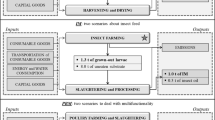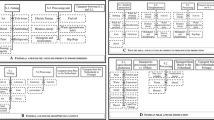Abstract
Purpose
Aquaculture is the best alternative to fulfil global fish demand, however it still relies heavily on fisheries-derived products for aquafeeds production. This study assesses and compares the environmental impacts of producing four experimental diets to gilthead seabream with different dietary protein (P) to carbohydrate (CH) ratios (P50/CH10 and P40/CH20). The diets were made either with fish meal (FM) or plant feedstuffs (PF) as main protein sources and fish oil (FO) or vegetable oils (VO) as lipid sources.
Methods
The functional unit used was 1 kg of experimental diet. The studied boundaries included aquafeed ingredients production (S1), compound aquafeeds production under laboratory conditions (S2), and transportation between S1 and S2 locations. The present study applied the Recipe Endpoint method, hierarchist version (V1.13; Europe recipe H/A). Background data was collected from ecoinvent database and related literature. For each aquafeed ingredient used, it was accounted either the agriculture production or fishery activities, the processing unit, and transportation between the production and processing locations. Ingredient mixing and processing was done at the Marine Zoology Station (MZS) located at Porto, Portugal. It was also taken into account the road transportation of aquafeed ingredients between a commercial company and the MZS.
Results and discussion
Regardless of dietary protein source or P/CH ratio used, all diets had the same single score index. In agreement with several studies, S1 was the system with the highest environmental impact. On the other hand, S2 was the lowest environmental contributor step to all formulated diets, except for diet P50/CH10, where the lowest environmental impact was related with the aquafeed ingredients transportation to MZS. Fisheries-derived ingredients were the biggest contributors to environmental impact. In the hypothesis of replacing FO from Portuguese fisheries by-products by FO of Peruvian anchovy fisheries or by soybean oil (SBO), the environmental impact of the diets would be decreased, being the replacement by SBO the best environmental alternative.
Conclusions
There was highlighted a tendency for PF-based diets having lower environmental impact score when compared to the FM-based diets after both hypothetical replacements. Studying the replacement of by-products FO by Peruvian anchovy FO or by SBO allowed to emphasize the importance of adequate ingredients selection for reducing the environmental impact. As limitations of the current study it is important to mention: the use of pelletization as manufacturing process and the non-valorization of fish by-products as recycled aquafeed ingredients.

Similar content being viewed by others
References
Abdou K, Aubin J, Romdhane MS, Le Loc’h F, Lasram FBR (2017) Environmental assessment of seabass (Dicentrarchus labrax) and seabream (Sparus aurata) farming from a life cycle perspective: a case study of a Tunisian aquaculture farm. Aquaculture 471:204–212
Achten WMJ, Acker K (2015) EU-average impacts of wheat production: a meta-analysis of life cycle assessments. J Ind Ecol 20:132–144
Almeida C, Vaz S, Ziegler F (2015) Environmental life cycle assessment of a canned sardine product from Portugal. J Ind Ecol 19(4):607–617
AOAC (2000) Official methods of analysis of AOAC. Association of Official Analytical Chemists, Gaithersburg
Aubin J (2013) Life cycle assessment as applied to environmental choices regarding farmed or wild-caught fish. CAB Reviews 8(011):1-10
Avadí A, Henriksson PJG, Vázquez-Rowe I, Ziegler F (2018) Towards improved practices in life cycle assessment of seafood and other aquatic products. Int J Life Cycle Assess 23:979–981
Avadí A, Pelletier N, Aubin J, Ralite S, Núñez J, Fréon P (2015) Comparative environmental performance of artisanal and commercial feed use in Peruvian freshwater aquaculture. Aquaculture 435:52–66
Beutler (1984) Starch. In: Bergmeyer HU (ed) Methods of enzymatic analysis vol. 6. Verlag Chemie, Weinheim, pp 2–10
Boissy J, Aubin J, Drissi A, van der Werf HMG, Bell GJ, Kaushik SJ (2011) Environmental impacts of plant-based salmonid diets at feed and farm scales. Aquaculture 321:61–70
Carvalho A, Mimoso AF, Mendes AN, Matos HA (2014) From a literature review to a framework for environmental process impact assessment index. J Clean Prod 64:36–62
Cavalett O (2008) Análise do ciclo de vida da soja. Universidade Estadual de Campinas, Campinas
Cavalett O, Ortega E (2009) Emergy, nutrients balance, and economic assessment of soybean production and industrialization in Brazil. J Clean Prod 17:762–771
Deng Y, Achten WMJ, Van Acker K, Duflou JR (2013) Life cycle assessment of wheat gluten powder and derived packaging film. Biofuels Bioprod Biorefin 7:429–458
Dias J, Conceição LEC, Ribeiro AR, Borges P, Valente LMP, Dinis MT (2009) Practical diet with low fish-derived protein is able to sustain growth performance in gilthead seabream (Sparus aurata) during the grow-out phase. Aquaculture 293:255–262
Edwards P (2015) Aquaculture environment interactions: past, present and likely future trends. Aquaculture 447:2–14
Enes P, Panserat S, Kaushik S, Oliva-Teles A (2008) Growth performance and metabolic utilization of diets with native and waxy maize starch by gilthead sea bream (Sparus aurata) juveniles. Aquaculture 274(1):101–108
Fantin V, Righi S, Rondini I, Masoni P (2017) Environmental assessment of wheat and maize production in an Italian farmers’ cooperative. J Clean Prod 140:631–643
FAO (2016) The state of world fisheries and aquaculture: opportunities and challenges. Food and Agriculture Organization of the United Nations, Rome 243 p
FAO (2018) The state of world fisheries and aquaculture: meeting the sustainable development goals. Food and Agriculture Organization of the United Nations, Rome, 227 pp
FAO (2019) Fisheries and aquaculture software. FishStatJ—software for fishery statistical time series. In: FAO Fisheries and Aquaculture Department [online]. Rome. Updated 21 July 2016. http://www.fao.org/fishery/. Accessed 25/02/2019
Fréon P, Avadí A, Vinatea Chavez RA, Ahón FI (2014) Life cycle assessment of the Peruvian industrial anchoveta fleet: boundary setting in life cycle inventory analyses of complex and plural means of production. Int J Life Cycle Assess 19(5):1068–1086
Fréon P, Durand H, Avadí A, Huaranca S, Moreyra RO (2017) Life cycle assessment of three Peruvian fishmeal plants: toward a cleaner production. J Clean Prod 145:50–63
García BG, Jiménez CR, Aguado-Giménez F, García JG (2016) Life cycle assessment of gilthead seabream (Sparus aurata) production in offshore fish farms. Sustainability 8:1228–1247
Gundoshmian TM, Ershadi SZ, Ebrahimi S (2017) Life cycle assessment of wheat production by using LCA methodology in Ardabil, Iran. Foreign Agricultural Economic Report ISSN: 0429-0577 101–108
Henriksson PJG, Mohan CV, Phillips MJ (2017) Evaluation of different aquaculture feed ingredients in Indonesia using life cycle assessment. IJoLCAS 1:13–21
Hofstetter P (1998) Perspectives in life cycle impact assessment—a structured approach to combine models of the technosphere, ecosphere and valuesphere. Kluwer Academic Publishers, Dordrecht
IEA (2016) Electricity heat in Portugal, available from the International Energy Agency
IFFO (2016) IFFO: fishmeal and fish oil statistical yearbook
Iribarren D, Moreira MT, Feijoo G (2012) Life cycle assessment of aquaculture feed and application to the turbot sector international. Int J Environ Res 6(4):837–848
ISO 14040 (2006) Environmental management—life cycle assessment—principles and framework. International organisation for standardisation (ISO), Geneve
ISO 14044 (2006) Environmental management—life cycle assessment—requirements and guidelines. International organisation for standardisation (ISO), Geneve
Izquierdo MS, Turkmen S, Montero D, Zamorano MJ, Afonso JM, Karalazos V, Fernández-Palacios H (2015) Nutritional programming through broodstock diets to improve utilization of very low fishmeal and fish oil diets in gilthead sea bream. Aquaculture 449:18–26
MapQuest (2018) Official MapQuest http://www.mapquest.com/. Accessed 14 august 2018
Martínez-Llorens S, Vidal AT, Moñino AV, Torres MP, Cerdá MJ (2007) Effects of dietary soybean oil concentration on growth, nutrient utilization and muscle fatty acid composition of gilthead sea bream (Sparus aurata L.). Aquac Res 38:76–81
Montero D, Grasso V, Izquierdo MS, Ganga R, Real F, Tort L, Caballero MJ, Acosta F (2008) Total substitution of fish oil by vegetable oils in gilthead sea bream (Sparus aurata) diets: effects on hepatic Mx expression and some immune parameters. Fish Shellfish Immunol 24(2):147–155
Naylor RL (2016) Oil crops, aquaculture, and the rising role of demand: a fresh perspective on food security. Glob Food Sec 11:17–25
NRC (2011) Nutrient requirements of fish and shrimp. The National Academies Press, Washington, DC
Olsen RL, Hasan MR (2012) A limited supply of fishmeal: impact on future increases in global aquaculture production. Trends Food Sci Technol 27:120–128
Pelletier N, Tyedmers P (2007) Feeding farmed salmon: is organic better? Aquaculture 272:399–416
Robaina L, Izquierdo MS, Moyano FJ, Socorro J, Vergara JM, Montero D, Fernández-Palacios H (1995) Soybean and lupin seed meals as protein sources in diets for gilthead seabream (Sparus aurata): nutritional and histological implications. Aquaculture 130:219–233
Rust MB, Barrows FT, Hardy RW, Lazur A, Naughten K, Silverstein J (2011) The future of aquafeeds vol 124. NOAA/USDA, Silver Spring
Samuel-Fitwi B, Meyer S, Reckmann K, Schroeder JP, Schulz C (2013) Aspiring for environmentally conscious aquafeed: comparative LCA of aquafeed manufacturing using different protein sources. J Clean Prod 52:225–233
Silva CB, Valente LMP, Matos E, Brandão M, Neto B (2018) Life cycle assessment of aquafeed ingredients. Int J Life Cycle Assess 23:995–1017
Strazza C, Magrassi F, Gallo M, Borghi AD (2015) Life cycle assessment from food to food: a case study of circular economy from cruise ships to aquaculture. Sustainable Production and Consumption 2:40–51
Tacon AGJ, Metian M (2008) Global overview on the use of fish meal and fish oil in industrially compounded aquafeeds: trends and future prospects. Aquaculture 285(1–4):146–158
Tacon AGJ, Metian M (2015) Feed matters: satisfying the feed demand of aquaculture. Rev Fish Sci Aquac 23:1–10
Tacon AGJ, Metian M (2018) Food matters: fish, income, and food supply—a comparative analysis. Rev Fish Sci Aquat 26:15–28
Van Stappen F, Loriers A, Mathot M, Planchon V, Stilmant D, Debode F (2015) Organic versus conventional farming: the case of wheat production in Wallonia (Belgium). Agric Agric Sci Procedia 7:272–279
Conflict of interest
The authors declare that they have no conflict of interest.
Funding
Catarina Basto-Silva and Inês Guerreiro were supported by FCT (Foundation for Science and Technology) grants (SFRH/BD/130171/2017 and SFRH/BPD/114959/2016, respectively).
Author information
Authors and Affiliations
Corresponding author
Additional information
Responsible editor: Ian Vázquez-Rowe
Publisher’s note
Springer Nature remains neutral with regard to jurisdictional claims in published maps and institutional affiliations.
Electronic supplementary material
ESM 1
(DOCX 43 kb)
Rights and permissions
About this article
Cite this article
Basto-Silva, C., Guerreiro, I., Oliva-Teles, A. et al. Life cycle assessment of diets for gilthead seabream (Sparus aurata) with different protein/carbohydrate ratios and fishmeal or plant feedstuffs as main protein sources. Int J Life Cycle Assess 24, 2023–2034 (2019). https://doi.org/10.1007/s11367-019-01625-7
Received:
Accepted:
Published:
Issue Date:
DOI: https://doi.org/10.1007/s11367-019-01625-7




